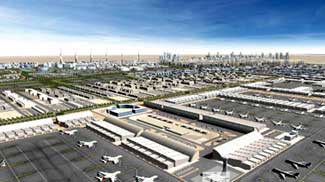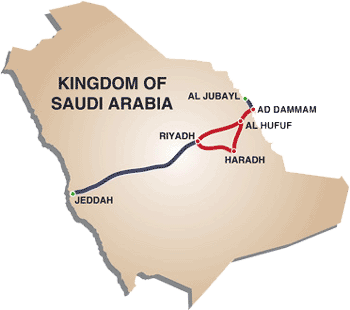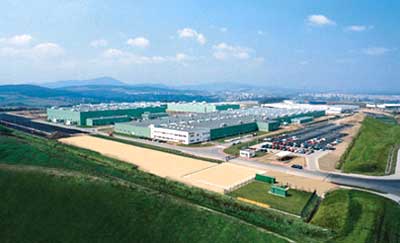
|
|
|
From Site Selection magazine, May 2005
WORLD REPORTS
|
|
|
Middle East Outlook
The incessant turmoil of the Middle East notwithstanding, the region is the scene of many planned major investments that bode well for its economic future. These include historic infrastructure projects, major research parks and a number of large industrial plants. The United Arab Emirates city of Dubai, in particular, is boosting its infrastructure in a large way to attract new industrial and scientific investment. And a proposed rail route across Saudi Arabia will link the Red Sea and the Persian Gulf for the first time. Here’s a look at some of the recent developments. More will be reported on in the July issue of Site Selection. Dubai Building Region’s
Largest Air-Sea Hub
several smaller “cities” that will cater to the financial, industrial, service and tourism industry needs connected to the aviation industry. The core of the city will be one of the world’s largest airports. The airport at Jebel Ali will be built 40 kms. (25 miles) from the current Dubai International Airport. The project will be built in phases. The US$547-million first phase will include a “Logistics City” and one runway. Initially, the focus will be on cargo requirements. The airport will consist of several terminals, six parallel runways and a large area for cargo. When completed, the airport will have capacity to handle 120 million passengers and 12 million tons of cargo annually. All facilities will be equipped to handle new generation aircraft, including the A380. Dubai government officials say the complex will serve the growing number of industries in the Jebel Ali industrial belt and should facilitate further industrial development in the area. Saudi Landbridge Will Link Red Sea to Gulf
The centerpiece of the project involves construction of a 950-km. (590-mile) stretch of rail connecting Riyadh to Jeddah on the Red Sea. This will make it possible for freight trains to travel from Jeddah to Riyadh in 12 hours and on to Dammam in another six hours. The 18-hour journey compares with the current five to seven days required for ships to travel around the Arabian Peninsula. Other pieces of the project are construction of a new 115-km. (71-mile) line between Dammam and Jubail, the country’s largest industrial city and a major center of the petrochemical industry. The rail connection to Jubail will provide a reliable and economical means of transport for the city’s industrial products to other parts of the country and export markets via Jeddah’s port. Also on the drawing board is an upgrade of the existing rail link between Riyadh and Dammam to provide for increased traffic volumes generated by the Landbridge. The Saudi Railways Organization is inviting private-sector participation in the project on the basis of a Build Operate Transfer (BOT) concession. Currently, the only railway in the country links Riyadh, the capital, with Dammam, the main port on the Gulf. – John McCurry
Eastern Europe Growing
in Nearly Every Department Overlay a map of Eastern Europe onto a map of ongoing European automotive investment and you’ll get a very clear picture: They’re practically one and the same. Spin-off is also rolling out across the region from logistics and materials companies eager to fill in the gaps in supply chain and construction. The most significant may be a $160-million expansion by U.S. Steel Corp. at its complex in Kosice, Slovakia, precisely to fill the construction and automotive industries’ demand in the region. A recent look at the Conway Data New Plant Database revealed that, since the beginning of 2004, two-thirds of all European automotive sector projects were slated for Eastern European countries, led by Poland, Slovakia and the Czech Republic. European Union subsidy, regulatory and corporate taxation debate may make some “Old Europe” nations look more attractive to the corporate eye. But not that attractive, given statements like this from a recent Boston Consulting Group report: “Today, the difference in the average hourly compensation of production workers (including benefits) between Germany and “New EU” countries can sometimes be as high as 90 percent. With forecasted growth rates of around 2 percent in Western European countries and 5 percent to 7 percent in “New EU” countries, labor cost convergence will take several decades because the differences in growth rates are quite small.” At press time, German officials were signaling their intent to hurry up that timetable by proposing EU-wide minimum wage standards. Polish Renaissance
Even before that, Poland recorded a high inflow of FDI in 2003, according to UNCTAD, attracting some $4.2 billion. Toyota has invested more than $309 million in engine and gearbox production in that country’s Walbrzych Special Economic Zone, and will increase employment there from 1,100 to 1,800 by the end of 2005. And GM unit Opel is adding 1,000 new jobs to a 2,000-worker payroll with new production lines at its Gliwice plant. In December 2004, hydraulics manufacturer Eaton Automotive announced it would build a plant on 25 acres (10 hectares) in the Katowice Special Economic Zone near Bielsko-Biala that will employ 375 people. As recently as early April 2005, German vehicle maker MAN AG was reported to be picking Poland over oncoming Slovakia, Hungary and Romania for a new truck manufacturing plant, driven by the low labor costs. The final decision will depend on MAN’s May board meetings. In February, 2005, French tire company Michelin announced it would invest more than $328 million in its Olsztyn complex, where it has purchased an additional 205 acres (83 hectares). Up to 520 new jobs will be created at the plant, which should be operating by 2006. It’s not all automotive: Korean concern LG Electronics, known for its mammoth Asian investments in cellphone handsets and liquid crystal display technology, is looking to invest US$130 million in a Polish television plant expansion. The country also has amended its popular special economic zone program to include business process outsourcing and service centers. Slovakia
The spin-off is still unwinding, most recently in early April 2005 when ArvinMeritor‘s LVS Liberec subsidiary said it would build a $3.7-million, 200-worker plant in Kysucke Nove Mesto to support its supply work for Kia’s new assembly plant near Zilina. Meanwhile, another Korean firm, Sewon ECS, is building a $20-million cable harness plant even closer to the Kia plant. The facility should be up and running by the end of 2005, and Sewon plans to employ as many as 600 within three years. In January 2005, Johnson Controls said it would invest $26.5 million in a seating system supply plant in Lucenec that will employ 340 people by 2007. In October 2004, Visteon announced it would invest $40 million in a new interiors and climate control systems plant in Nitra, which will employ 400. It’s the 11th facility investment in eastern Europe for the company, which also operates plants in Novy Jicin, Rychvald and Hluk, Czech Republic; Praszka and Poznan, Poland; and Szekesfehervar, Hungary. James Glerum, Cyril Leonard’s lead man in Central Europe, says the Slovakia success story traces back to Volkswagen’s original investment in the country after it became independent, building on the country’s automotive heritage with its purchase of its Skoda brand. “Slovakia by 2010 is anticipated to be able to deliver 1,100,000 new cars per annum to the market — the majority of these will go for export,” he says. “The automobile manufacturing industry contributed 21.6 percent of total exports in money terms in 1998, growing to 26.9 percent in 2002 and breaking through the 30-percent barrier (30.7 percent) in 2004.” Slovakia too is already branching out in its FDI portfolio. Bratislava was selected in October 2004 as the regional administrative hub for chemical giant BASF. Czech That
DENSO opened a $255-million plant in the popular city of Liberac in May 2004. The company’s overall facilities in Liberac will eventually employ some 1,600 people. Stant Manufacturing Inc. is creating 100 jobs at a new plant in the Moravian city of Karvina. Company leaders have hinted at bringing design work to the location as well. Another Moravian city, Kunovice, will see an 80-worker, $8.5-million investment from Belgian mechanical component maker Meister Group. And Germany’s Pierburgh GmbH will invest more than $13 million in a 50-job plant in Trmice. Joining the Party
In November 2004, Toyota executives were reported to be planning further investments in the company’s Turkish unit, in addition to the $515 million the company has invested there in the previous four years. In Romania, DURA Automotive Systems is opening a 50,000-sq.-ft. (4,645-sq.-m.) factory in Timisoara, adding to a regional footprint that includes three plants in the Czech Republic and one in Slovakia. A joint venture between tire giants Pirelli and Continental is commencing steel cord production in Slatina, investing nearly $31 million and employing up to 350 people. In Hungary, materials is the byword, with a $2.6-million building materials complext from homegrown Frikober Engineering in Sumeg, a $10.4-million rolled steel plant from Danish firm Ib Andersen Industri. In Lithuania, FDI grew from $123.7 million in 2003 to $481.9 million in 2004, with more than three-quarters coming from other EU countries, led by Denmark, Sweden and Germany. The most promising harbinger for industry? A total of 34 percent of the total FDI went to manufacturing. Demographic Shifts Coming Onto Radar?
The report says overall population in the 10 new EU countries will drop by more than 11 percent by 2050, and that working age population (ages 15-64) will drop in the EU overall by a similar percentage. While such long-range projections are to be taken with a large dose of skepticism, the nearer-term projections are not any brighter: 2004 saw population decreases in the Czech Republic, Estonia, Latvia, Lithuania, Hungary, Poland and Slovakia. And by 2015, the population in the new member states is projected to have dropped by 1.5 million. – Adam Bruns
|
|||||||
|
|
|||||||

©2005 Conway
|


